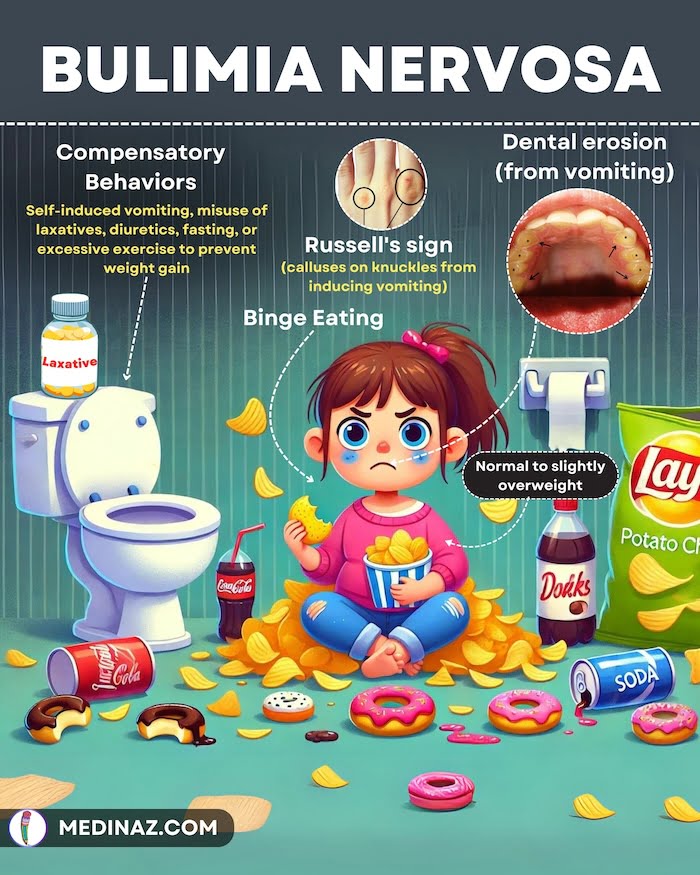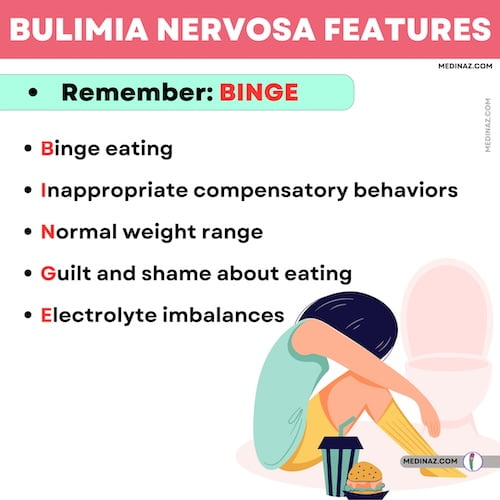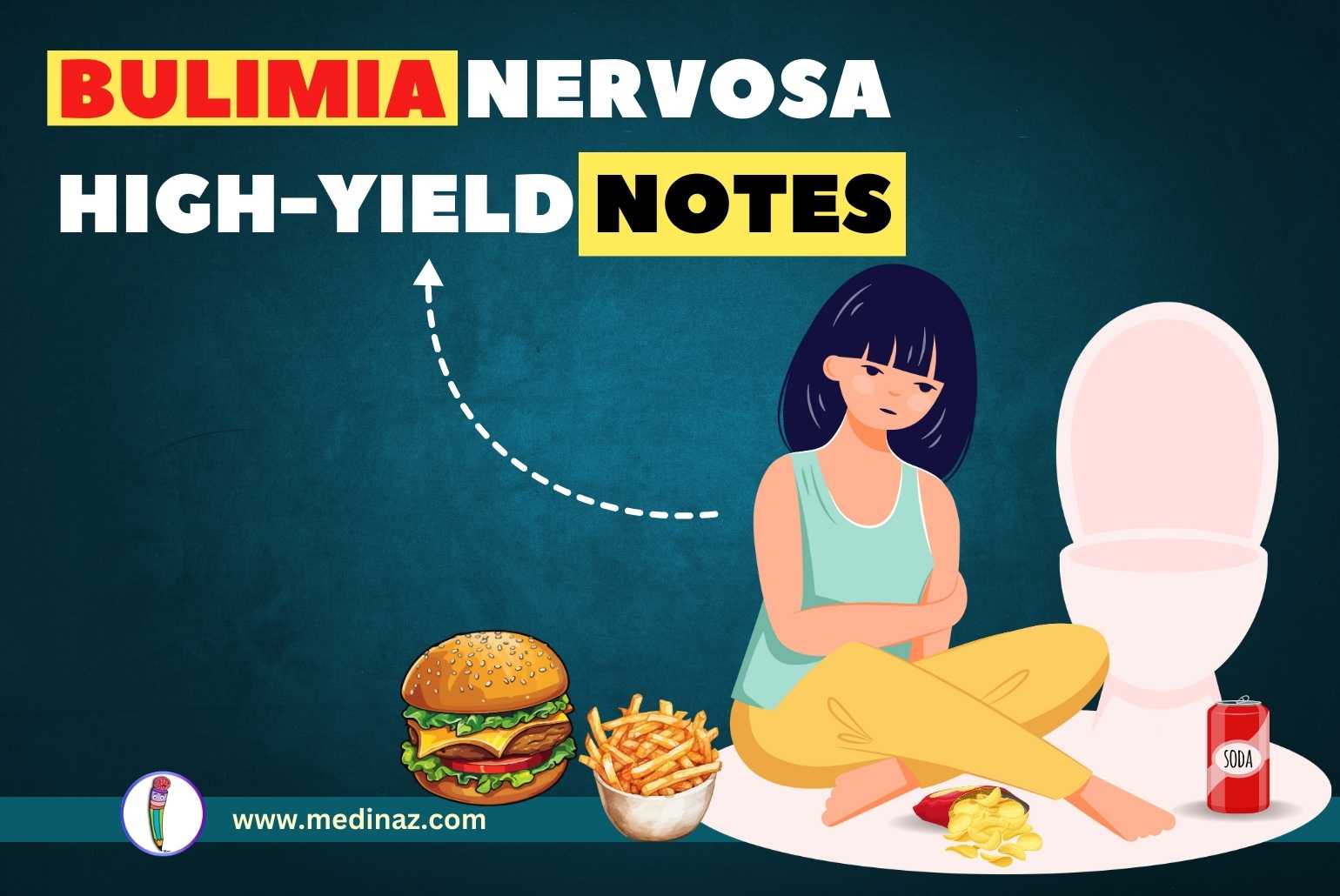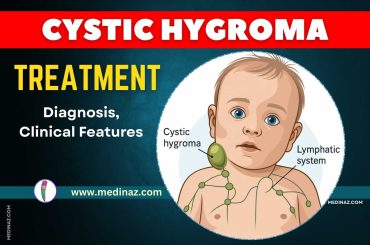Bulimia Nervosa – High-Yield Notes for USMLE, NCLEX, NEET PG exams
Introduction
- Definition: Bulimia nervosa is an eating disorder characterized by recurrent episodes of binge eating followed by inappropriate compensatory behaviors to prevent weight gain.
- Etiology: Multifactorial, involving genetic, environmental, and psychological factors.
- Epidemiology: More common in females, typically onset in late adolescence or early adulthood.
Pathophysiology
- Binge-Purge Cycle:
- Binge Eating: Consumption of an excessively large amount of food in a discrete period, often with a sense of lack of control.
- Compensatory Behaviors: Self-induced vomiting, misuse of laxatives, diuretics, fasting, or excessive exercise to prevent weight gain.
- Psychological Factors: Body image distortion, low self-esteem, and high levels of impulsivity and perfectionism.
Clinical Features
- Behavioral Symptoms:
- Recurrent episodes of binge eating
- Recurrent inappropriate compensatory behaviors
- Preoccupation with body weight and shape
- Physical Signs:
- Normal to slightly overweight body weight (BMI 18.5-29.9)
- Parotid gland enlargement
- Dental erosion (from vomiting)
- Russell’s sign (calluses on knuckles from inducing vomiting)
- Electrolyte imbalances (hypokalemia, hypochloremia, metabolic alkalosis)
- Gastroesophageal reflux disease (GERD)
- Menstrual irregularities

Risk Factors
- Genetic predisposition
- Family history of eating disorders
- Psychiatric comorbidities: Depression, anxiety disorders, substance abuse
- Sociocultural factors: Emphasis on thinness and body image in media and society
Diagnosis
- DSM-5 Criteria:
- Recurrent episodes of binge eating, as characterized by both:
- Eating, within any 2-hour period, an amount of food that is definitively larger than what most individuals would eat in a similar period of time under similar circumstances.
- A feeling that one cannot stop eating or control what or how much one is eating.
- Recurrent inappropriate compensatory behaviors in order to prevent weight gain such as self-induced vomiting; misuse of laxatives, diuretics, or other medications; fasting or excessive exercise.
- The binge eating and inappropriate compensatory behaviors occur, on average, at least once a week for 3 months.
- Self-evaluation is unjustifiability influenced by body shape and weight.
- The disturbance does not occur exclusively during episodes of anorexia nervosa.
- Recurrent episodes of binge eating, as characterized by both:
- Laboratory Tests:
- Electrolyte panel (to detect imbalances)
- Complete blood count (CBC)
- Liver function tests (LFTs)
- Amylase levels (elevated in vomiting)
Treatment
- Psychotherapy:
Cognitive-behavioral therapy (CBT): First-line treatment; focuses on altering dysfunctional thoughts and behaviors related to eating.
- Pharmacotherapy:
- SSRIs (e.g., fluoxetine): FDA-approved for bulimia nervosa
- Antidepressants: To manage comorbid depression and anxiety
- Nutritional Counseling: Establishing regular eating patterns and addressing nutritional deficiencies.
- Medical Monitoring: Regular monitoring of electrolytes and physical health.
Complications
- Electrolyte Imbalances: Hypokalemia, hypochloremia, metabolic alkalosis
- Cardiac Arrhythmias: Due to electrolyte disturbances
- Esophageal Tears: Mallory-Weiss syndrome
- Gastrointestinal Complications: GERD, constipation, bloating
- Dental Problems: Enamel erosion, caries
- Psychiatric Complications: Depression, anxiety, substance abuse
Prognosis
- Outcome: Variable; with appropriate treatment, many patients achieve remission.
- Factors Affecting Prognosis: Early intervention, adherence to treatment, presence of comorbid conditions.
Prevention
- Education and Awareness: Promoting healthy body image and eating habits.
- Early Detection: Screening for eating disorders in at-risk populations.
Mnemonics
- BINGE for features of Bulimia Nervosa:
- Binge eating
- Inappropriate compensatory behaviors
- Normal weight range
- Guilt and shame about eating
- Electrolyte imbalances

Chart: Diagnostic Approach to Bulimia Nervosa
| Step | Diagnostic Tool | Purpose |
|---|---|---|
| 1 | Clinical Examination | Identify physical signs and symptoms |
| 2 | DSM-5 Criteria | Confirm diagnosis |
| 3 | Laboratory Tests | Detect electrolyte imbalances, organ damage |
| 4 | Psychological Assessment | Evaluate comorbid psychiatric conditions |
Table: Treatment Modalities for Bulimia Nervosa
| Treatment Modality | Example(s) | Remarks |
|---|---|---|
| Psychotherapy | Cognitive-Behavioral Therapy (CBT) | First-line treatment |
| Pharmacotherapy | Fluoxetine (SSRI) | FDA-approved, helps reduce binge-purge cycles |
| Nutritional Counseling | Dietitian support | Establishes regular eating patterns |
| Medical Monitoring | Regular electrolyte checks | Monitor for complications |
Key Points
- CBT is the first-line treatment for bulimia nervosa.
- Fluoxetine is the only FDA-approved medication for bulimia nervosa.
- Electrolyte monitoring is essential due to the risk of severe imbalances.
- Early intervention can significantly improve outcomes.
Check other important USMLE Notes
A Visual Learning Platform





